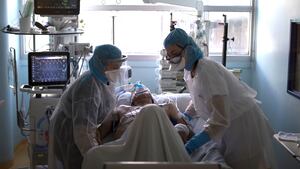When Art Sanchez answered the phone, something seemed off. He sounded too perky, too healthy, too… oxygenated.
But yes, he confirmed, this was Arthur Sanchez of Las Cruces, New Mexico–the fourth person in the world to receive a double lung transplant after COVID-19.
“It’s a miracle!” he exclaimed. “When people see me now, [they] are amazed that I had a lung transplant in August.”
But as the coronavirus ravages more and more Americans' lungs, what seems like a miracle now could soon become standard. Already, Northwestern Memorial Hospital in Chicago has received double the number of transplant requests it gets in a given year. Other hospitals are getting multiple requests a week.
Northwestern’s chief of thoracic surgery, Dr. Ankit Bharat, says he expects hundreds more COVID patients to require lung transplants in the coming years—nearly all of them doubles.
"I have no doubt that the need for transplant in these patients is going to go up, at least in the imminent future,” Bharat said.
More than 2,000 people get lung transplants in the U.S. every year, and that number is steadily growing. So far, however, the number performed on COVID patients is less than 100. The first transplant on an American COVID patient took place in June—four months and nearly 100,000 deaths after the first case was detected on U.S. shores.
It seems like it should be an obvious fix: COVID destroys someone's lungs; doctors give them new ones. But, of course, it’s not that simple. Maybe the patient whose lungs are failing has other complications, too: sepsis, strokes, multiple organ failure. Maybe they’re weak and deconditioned from weeks spent on a ventilator. So then you’ve given a set of lungs to someone who will likely die anyway, and that’s one less pair for the kid with cystic fibrosis on the fifth floor who could take them and survive.
Then there’s the question of whether this patient actually really needs the lungs. At the beginning of the pandemic, doctors didn’t know if people’s lungs would eventually just heal on their own—like someone with pneumonia or the flu—or if, worst-case scenario, the virus would live on undetected in their body and infect the new organs.

A transplant patient’s old lung shows the ravages of COVID-19.
Northwestern MedicineSo what doctors needed was a patient who was really, really sick—we’re talking zero other options—but also healthy enough to undergo a major surgery and probably live a long, healthy life afterward. A patient like Art Sanchez.
Sanchez is young—52—and healthy, with no underlying conditions. (Well, OK, he’s a little overweight, but he’s very active.) Before he got sick, he and his wife were building a new home on their own. When he got sick, though, he got really sick. At the time, he assumed the coronavirus was like a bad flu. But then his sister got it, and her husband got it, and his 97-year-old mom got it. And then his sister and her husband had to be hospitalized, leaving Sanchez to take care of his mom, so of course he got it, too.
By the time Sanchez started having trouble breathing on Easter weekend, he was already familiar with the symptoms. He checked himself into the hospital that Sunday.
“At that point it just went downhill fast,” he said. “I don't remember too much more than being rushed back into the ICU.”
Sanchez was in the ICU in New Mexico for almost four months—first on a ventilator and then on ECMO, a heart-lung machine. Most people on ECMO are on it for a week or two. Sanchez was on it for more than 90 days.
“They were waiting to see what was going to happen to my lungs,” he explained, meaning, waiting to see whether he really needed the transplant—whether he was, as one doctor put it, “end stage.” He was. “They finally determined there was irreversible damage,” he said.
Miraculously, however, none of Sanchez’s other organs had failed. He had been in the ICU for months, but his condition was stable. He was exactly what doctors were looking for in a transplant candidate: All he needed was a new set of lungs.
Finding new lungs, however, can be tricky. The wait list for lungs in the U.S. is currently about 1,000 people long. The wait-list mortality rate—the term doctors use for the number of people who will die each year while waiting for a lung—is about 10 percent. That means this year, about 100 people will die because they couldn’t get one.
So far, the pandemic hasn’t shifted those numbers dramatically. The number of COVID patients who’ve actually been able to get a lung transplant is low, somewhere in the double digits. Northwestern received more 350 referrals for COVID-related lung transplants last year, more than doubling its usual number of referrals, but has completed just 10. Only a handful of other transplant centers, including the University of Florida, have performed the procedure at all.
“I don't think we’re talking about something that is going to solve COVID lung diseases for all patients,” said Dr. Tiago Machuca, chief of thoracic surgery at UF. “It's going to be a very small percentage of patients that are going to be candidates for it.”

Mayra Ramirez, 28, and Drs. Ankit Bharat and Rade Tomic after her successful double-lung transplant.
Northwestern MedicineStill, those numbers are likely to go up as the procedure becomes more widely accepted. Just last month, surgeons at Northwestern published a case study confirming what many had suspected all along: Yes, some COVID patients develop end-stage lung disease, and yes, a lung transplant could help them. For some patients, they wrote, “lung transplantation is their only option for survival.”
And there is another group that surgeons have only just started researching: patients who are discharged from the hospital but never fully recover. Some of these patients go home on oxygen while others stay on ventilators in long-term care facilities, alive but unable to leave their beds. Eventually, these patients will need transplants, too.
“Imagine the millions of patients that have been infected and thousands that had severe forms of illness,” said Bharat, who co-authored the Northwestern study. “I think we need to be prepared to help those patients if they were to develop severe enough lung injury.”
The approval of a vaccine is a sign of hope, he added, but “that vaccine’s not going to help the patients who are already infected.”
And that’s where the trouble could really start. If the number of COVID patients getting lung replacement continues to grow, as the doctors predict it will, it could put a strain on the national stockpile. Already, surgeons are engaged in internal debates about the ethics of putting a COVID patient on the transplant list when so little data exists about its efficacy.
According to Dr. Dan McCarthy, a cardiothoracic surgeon at the University of Wisconsin, that’s why some of the country's biggest transplant centers still aren't taking COVID patients: It’s not that they can’t do the surgery, they just don’t know if they should.
“Is this really the best use of organs? Are we taking organs and using them for patients who are less likely to use those scarce resources to their fullest extent?” McCarthy asked. “Because we don't have any long-term data right now, that is a concern that is impossible to completely alleviate."
McCarthy’s hospital has decided it’s worth the risk. The University of Wisconsin has already performed one transplant and has several other patients on the waiting list. Their first patient likely would not have left the hospital without a new set of lungs; she is now home and off oxygen.
“The reality is, all of us are dealing with horrible stories of patients right in front of us that are dying or stuck on a ventilator or in the ICU. Young, healthy patients with families and a bright future ahead of them,” he said. “When you’ve decided there's no hope for recovery, the options really become quite stark: It’s either we do a transplant or we let them die peacefully.”
Sanchez was lucky; his bout of illness came before any kind of pandemic-related rush on lungs. He was transferred to St. Joseph’s Hospital in Phoenix in August and matched with a new pair of lungs two weeks later. He was in the hospital recovering for six weeks and in rehab for another six weeks after. After so much time in bed, he had to train his muscles how to walk again, teach his new lungs how to breathe.
The physical part wasn’t so difficult, Sanchez says, but the emotional impact was striking. He likes to think of himself as the protector of his family, and hates to imagine them all—his wife of 30 years, his two adult daughters—making decisions about his care on their own, not knowing whether he would live or die. The families of other patients have started calling him lately, asking him how to deal with all of it. He tells them: “Hang in there and stay strong.”
So far, Sanchez is feeling pretty strong himself. He can’t lift as much weight as he used to, or exert himself for as long, but he’s back at work— and back to fixing up the house.
He doesn’t remember much of his time in the hospital—a side effect of the sedation—but he does remember a slogan plastered on the walls of St. Joseph’s. It said, simply, “Human kindness.”
“It’s been amazing to see how this virus has pulled people together in that sense,” he said. “We experienced that all throughout the journey.”
“I tell people that that slogan that St. Joseph's really means a lot,” he added. “Human kindness. We need to be good to everybody."


